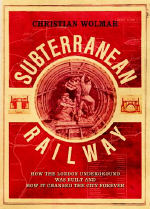Subterranean Railway Review
 Few Londoners have a good word for the Underground. Every day something seems to go wrong — faulty signals (even on the new section of the Jubilee Line), an “incident” (ie, suicide) on the line, engineering works. So rare is a day without a hold-up that the management now boasts of “good service” when it means simply normal service. Most Londoners see the Tube as a badly run, strike-prone bureaucracy that requires a multimillion-pound injection every year.
Few Londoners have a good word for the Underground. Every day something seems to go wrong — faulty signals (even on the new section of the Jubilee Line), an “incident” (ie, suicide) on the line, engineering works. So rare is a day without a hold-up that the management now boasts of “good service” when it means simply normal service. Most Londoners see the Tube as a badly run, strike-prone bureaucracy that requires a multimillion-pound injection every year.
How strange, therefore, to be reminded that before the Second World War the Underground was seen as an engineering marvel and London Transport regarded as a model of efficient management. Like Lord Reith’s BBC, LT — the creation largely of Herbert Morrison — embodied the virtues of public service, paternalist employment policies and pioneering design (its posters and famous schematic map had a huge impact). The Underground was envied and copied around the world.
London Transport came just in time to hold the Underground together before the onslaught of the private car. Until then, as Christian Wolmar shows in his masterful account of the Tube’s origins, London saw no need to plan or co-ordinate lines built as profit-making enterprises by railway companies that spent more time doing each other down than working out the needs of passengers or the capital’s development.
The pioneer was the Metropolitan, and its cut-and-cover line from Paddington to Farringdon was, from the start, an astonishing success. It was opened in 1863, and within a year 11.8 million people used the line — more than four times London’s population. It enabled thousands to get to work more quickly, linked the new mainline termini and became a vital artery beneath the surface gridlock. The Met saw the potential of allowing through trains from other companies on its tracks, and by 1865 a staggering 352 departed from Farringdon every weekday. Underground mania hit London: 259 different projects for 300 miles were submitted to Parliament. But two things plagued development: the use of steam and the titanic feud between the Metropolitan and the rival, poorer District.
Steam in tunnels made journeys dirty and unpleasant but the little engines were as reliable as the signals: in 44 years of steam operation there wasn’t one fatality. Only when electric traction became possible, in the 1900s, could the deep tunnel tubes be built, the heart of today’s system.
Wolmar tells how a dodgy American, Charles Yerkes, raised the cash and built three Tube lines in ten years. A century later, after 50 years of underinvestment, London has asked another American, Bob Kiley, to sort out Yerkes’s neglected legacy. Users, in their millions, hope that he can.
Review by Michael Binyon, 20 November 2004
